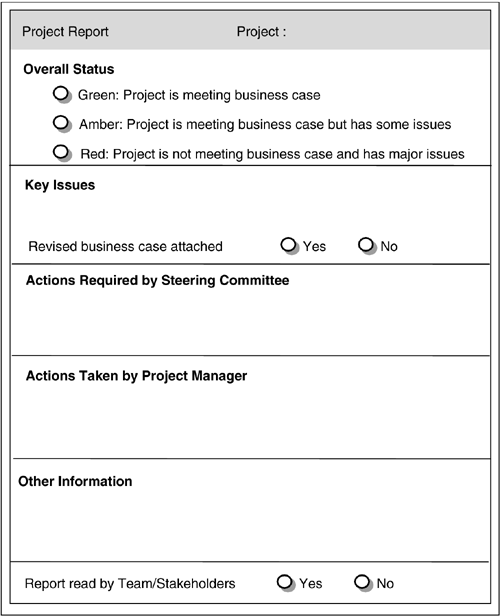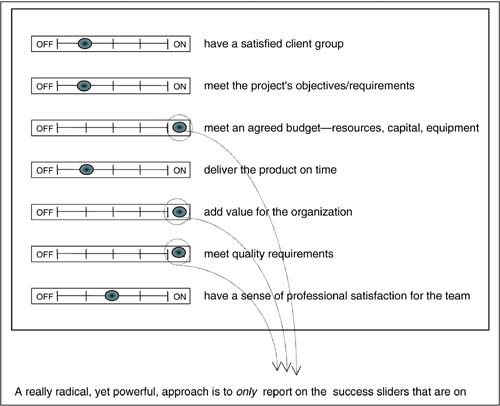Project Reporting
| The final step in the project management model is the reporting of the status of the project at a summary level to the project sponsor, project steering committee, and stakeholders (see Figure 17.4). Figure 17.4. Project reporting The proactive nature of the project sponsor and project steering committee was introduced in early parts of this book. Rather than the rubber stamping and passive behavior that many steering committees were relegated to in traditional project management, eXtreme project management actively involves these executives in:
The selection and initiation of projects was covered in Chapter 5 of this book. In this chapter, we explore the other key functions of steering committees and project sponsors. As also discussed in earlier chapters, it is important that the senior management take responsibility and accountability for the projects they are sponsoring. Your role, as a project manager, is critical in assisting senior management (who are generally from the process culture and are generally not sure of their role in projects) in both gaining access to the right information regarding their project and the right decisions to make. Project Management and Technical Deliverable ReviewsAs discussed in Chapters 3 and 5, projects involve the interrelationship between the managerial aspects (business case) and the technical aspects (system or product development deliverables). Review of the quality of the various technical deliverables such as system data, function requirements, designs, and so on, is best achieved through quality assurance processes such as walkthroughs and inspections, covered earlier. The same distinction between technical reviews and project management reviews applies to the role of steering committees and project sponsors. The project sponsor and steering committee reporting and reviewing roles are to focus on the business case and whether there is any variation in the agreed-on business case. Should the project manager wish to use either the project sponsor or members of his or her steering committee to provide technical input or to review detailed technical issues, this should be done outside the normal sponsor and steering committee reviews. It is common for project sponsors and members of the steering committee to be experts in areas of knowledge relevant to the project. For example, the general manager of marketing might be one of the most experienced people in the marketing issues relevant to a new retail banking system. This person is also on the project steering committee. As a result, you should separate the two roles that the general manager of marketing has on his or her project.
The governance of the business case is a steering committee role and the detailed technical input role regarding marketing issues is a technical review role and should be handled as part of the system development process. In our example, if the project manager wishes to alter the scope and objectives of the project based on new information gathered during the system development process, this is a decision that must be made by the steering committee. If there are some detailed issues on the impact of the new system design on marketing strategy, this is a technical issue and would be resolved as part of a quality assurance review or systems analysis. The Project Reporting and Review ProcessThe format and timing of project reporting will vary in each organization and will also depend on the size and risk of the project.
For small projects, there is normally only a project sponsor and because small projects are generally less than three months in duration, a project review with the sponsor should occur either weekly or biweekly. For medium projects, there would normally be a steering committee and meetings would normally be monthly. For larger projects, there may be a project steering committee and an IT steering committee, so meetings might be monthly or quarterly. High-risk and extreme projects are subject to more change and turbulence and, as a result, the project reporting and review process may be more frequent and demand driven. In large, high-risk projects, it would be normal for the steering committee to delegate the demand-driven reporting role to the project sponsor or a subcommittee, as it often is too difficult to convene the steering committee on short notice. As discussed earlier, the following information is the core of the project reporting and review process:
Figure 17.5. Project report In addition, project reporting would typically involve a summary of the project tracking information such as costs, effort and schedule progress, and variations. As detailed in the sidebar, there should be adequate information and time for the project sponsor and steering committee to understand the issues and be able to make informed decisions. Really Radical ReportsAn extremely radical model implemented by one of our clients based the project reporting process on the success sliders introduced in Chapter 7. This approach is shown in Figure 17.6. Figure 17.6. A really radical report This approach recognizes that senior management are only interested in those success criteria that really matter to them. For example, if quality really mattered ("on") and budget was "off," why would you report on budget? Assistance to ProjectsAs detailed in earlier chapters and later in Chapter 20, the key role of the project sponsor and steering committee is to "add value" to the project and to the project management process. This requires the members of these groups to focus on proactive problem resolution of changes before they are implemented rather than the traditional reactive approval of changes after they have happened . Resolution of Project ConflictsAlso, as discussed in Chapter 5, a common form of assistance that the project sponsor and steering committee members will be required to provide is in the area of stakeholder management.
Given the number of different stakeholders in most projects, you will inevitably experience conflict between yourself and key stakeholders (and their managers) and conflict between stakeholders themselves . For example, a project manager may find a stakeholder, who is organizationally more senior than the project manager, not prepared to release a key person to assist in the project. Alternatively, a project manager may find two key stakeholders not agreeing on scope, objectives, or quality. In these and similar cases, it is legitimate for the project manager to raise the problems with either the project sponsor or project steering committee for assistance and resolution. Project Steering Committee Meeting StructureThe structure and agenda of project steering committee/sponsor meetings will vary, but all project steering committee/sponsor meetings should focus on the following topics or agenda items:
Reporting to StakeholdersIt is essential that the same processes and information be both gathered from and distributed to the project's stakeholders.
For critical stakeholders, the project reports should be actively reviewed via stakeholder meetings or one-on-one sessions. For nonkey stakeholders, it would be adequate for them to receive copies of all project tracking summaries and project reports. Ideally, an executive from each of the key stakeholder areas would be on the project steering committee as well. |
EAN: 2147483647
Pages: 136



